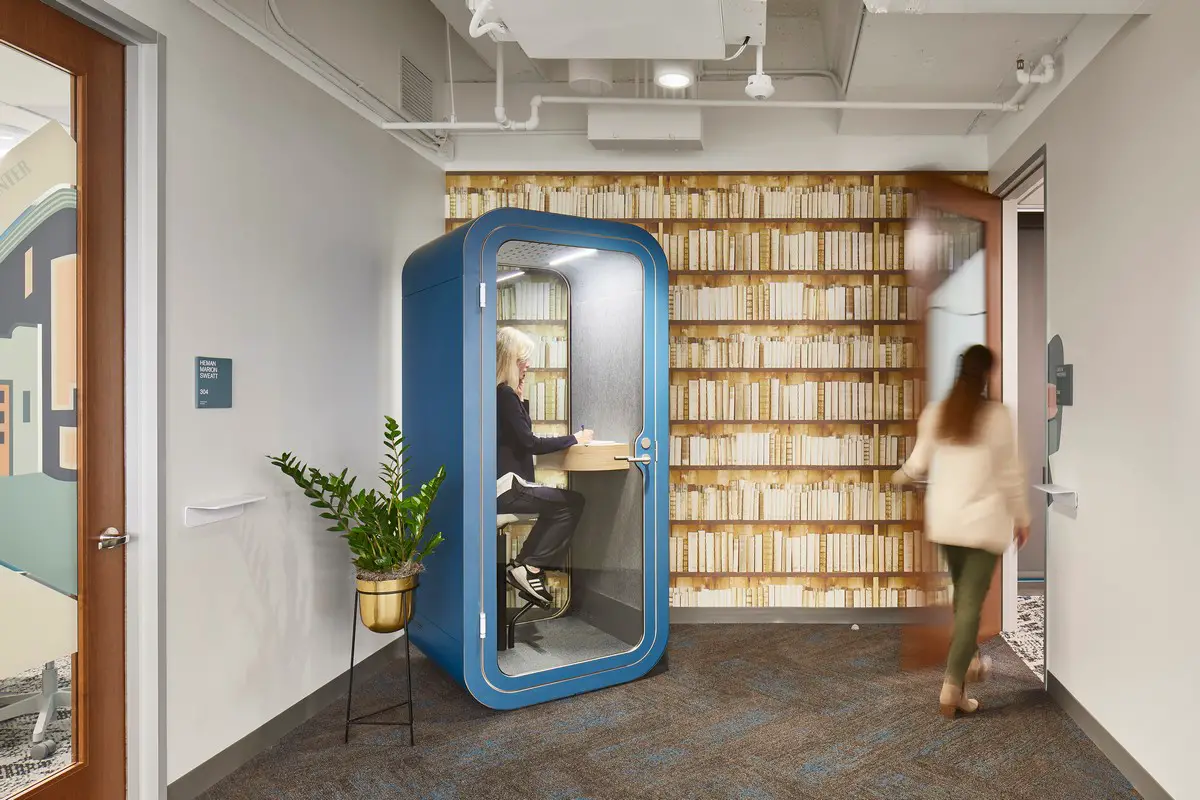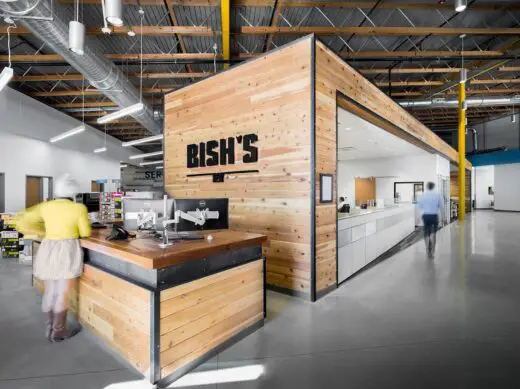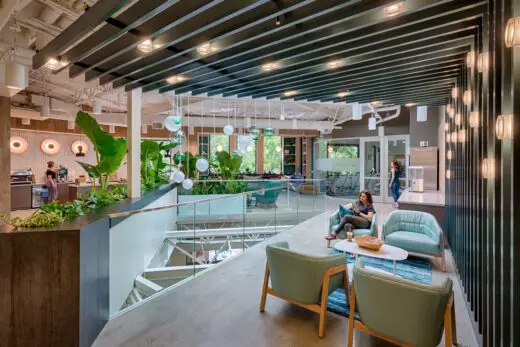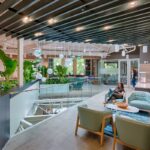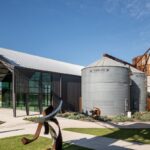Next generation of knowledge work, USA hybrid workplaces, American office design, US commercial property
Next Generation of Knowledge Work
April 28, 2023
Two Drydock boasts premier amenities including a fitness center and a roof deck, designed by SGA, at 2 Drydock Avenue, Boston, MA 02210, United States of America:
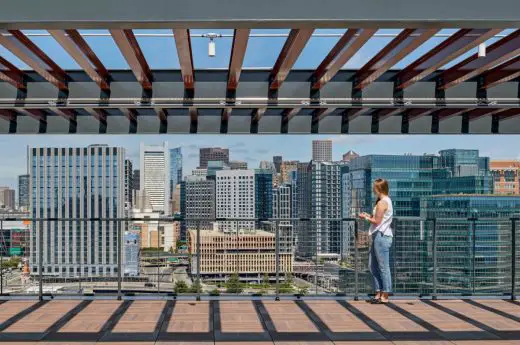
photo courtesy of architects office
Workplace Amenities
Workplace Amenities Report released amidst Flight to Quality in Commercial Real Estate
A Valuable New Toolkit Presents the Results of a Multi-Generational Survey and Key Emerging Trends in Commercial Amenities
Boston & New York City, USA – a national, multi-disciplinary firm, SGA, released its highly-anticipated 2023 Workplace Amenities Report. To help developers and employers identify the most desirable amenities for today’s workforce, the firm’s world-class interior design team surveyed hundreds of employees spanning generations, locations, and industries to gauge their preferences for workplace amenities across four main categories: health and wellness, productivity and meeting space, daily convenience, and transportation.
“The state of the workplace and workers’ needs are constantly shifting” comments Gable Clarke, President of Interior Design and Partner at SGA. “While our clients know that amenities are a critical piece of boosting employee engagement, there is confusion about how robust their amenity program should be and where they should be focusing their efforts.”
With hybrid work spurring a nationwide “flight to quality” trend in commercial real estate, creating higher quality spaces and amenities that transform the workplace into a destination have become essential components of attracting employees and tenants back to the office.
Designed by SGA, Norfolk + Dedham features stunning lounge areas for flexible workstyles, Dedham, Massachusetts, United States of America:
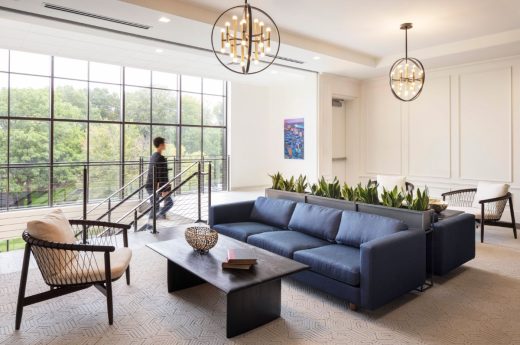
photo courtesy of architects office
Overall, the results of the survey demonstrate a reflection of larger societal shifts: a greater focus on personal well-being and safety, interest in sustainable modes of transportation, convenient places to grab food and packages, and spaces that facilitate social interactions.
It also reinforces the importance of notable amenities such as staffed security desks and reservable meeting rooms while identifying emerging trends like IT bars, bike parking and gender-neutral restrooms.
Previously on e-architect:
June 21, 2022
Article by Tammy Jones, Director of Human Resources, Cushing Terrell
The Next Generation of Knowledge Work: Lessons Learned on the Path to Hybrid Workplaces
The ability to choose a space designed to meet the specific needs of a task or activity is something offices provide that most at-home environments do not allow for:
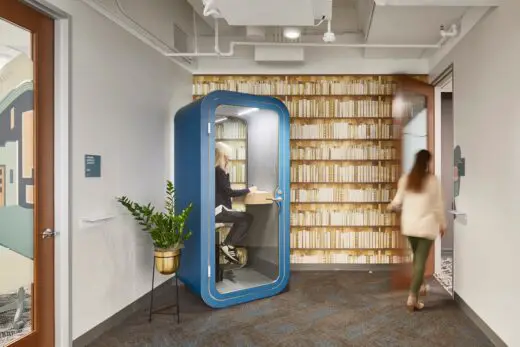
photo : Andrea Calo
Hybrid Workplaces – Knowledge Work
Shuffling from the bedroom to the in-home office, by way of the coffee bar in your kitchen is about as short and efficient a commute as you’ll find. We’ve all enjoyed the benefits of this abbreviated “trip to the office” since the knowledge worker community was almost universally sent home just over two years ago. But now, as we begin to “live with the pandemic” and gathering places, such as collaborative workspaces, resume full occupancy, how do we convince ourselves to get back in the car, or on the bus, to head back to the office? Or better yet why?
Like anything, work-from-home is not a perfect solution, and it’s not for everyone, and certainly not for everyone all the time. Aspects of a home office setting work quite well and suit certain roles, personality types, or lifestyles. Other aspects make focus time, collaboration, and creativity difficult to wrangle.
As a design firm, we’ve not only faced this predicament as a consultant, but also as an employer. As such, we’ve kept careful tabs on some of the pros and cons that have repeatedly emerged across a variety of knowledge-worker firms.
Working from home and hybrid work situations aren’t entirely new concepts. But with the onset of the pandemic, adoption rates skyrocketed out of necessity. Easing into the idea became a non-option, leaving most companies without much of a plan, and typically without a policy. Which brings us to our first key learning:
Flexible / hybrid work policy
1. A flexible/hybrid work policy that clearly defines how your team is able or expected to work is critical.
Cushing Terrell is a multidisciplinary design firm with offices and projects across the nation, so we were already accustomed to doing at least some aspects of our jobs remotely long before the pandemic dictated it was necessary. We had most, if not all, of the tools in place to support a dispersed team. But the vast majority of our team was assigned to and worked within one of our thirteen offices; so, while we had the tools and the workflow, what we didn’t have was a formal policy to outline company expectations.
Team member-to-team member communication took on renewed importance during the height of the pandemic. With new variables in the work-life balance, individual accountability is critical:
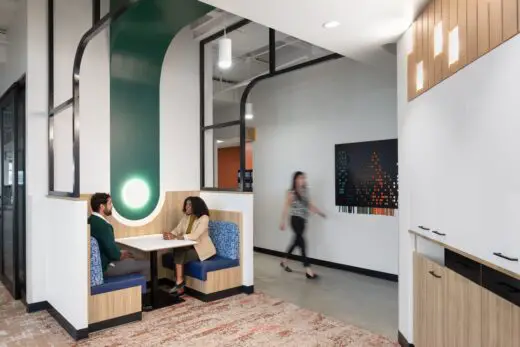
photo : Sean Fleming
About a year into the pandemic, our HR team, in partnership with firm leadership, went to work developing a program in response to questions from our team members and as a way to better understand their needs. The program we eventually drew up is called WorkSmart, a flexible work arrangement designed to acknowledge and embrace flexibility in our work environments and preferences. Our team members get to choose if they would like to work remotely, operate with a hybrid schedule, or work in the office full time. This program, built on a more formalized HR policy, ensures our team members can select the work situation that suits them best, while at the same time providing a framework upon which we can evaluate team member distribution and associated needs.
With our flexible work policy now formalized, we have the guidelines needed to establish how and where we conduct business, but we’re also inevitably left with the question of how to make the best use of our office space. Sure, technology has made work from home possible, but the office experience still has many advantages. This brings us to our second key learning:
Offices provide agency
2. Offices provide agency.
Our in-house workplace design experts have spent many years working with dozens of clients to leverage this benefit of agency in the office. Even the most basic workplaces tend to have a variety of spaces designed to cater to anticipated needs of those who work there. For example, an office may have independent workstations for focus time as well as conference rooms ranging in sizes to accommodate group work or private meetings. Some may include an even wider array of space types such as outdoor workspaces, tranquility rooms, and classrooms or libraries, among others. This ability to choose a space designed to meet the specific needs of a task or activity is something most at-home environments do not allow for.
Agency, in addition to the innate collaborative aspects of shared workspaces, will increasingly define the next generation of office design:
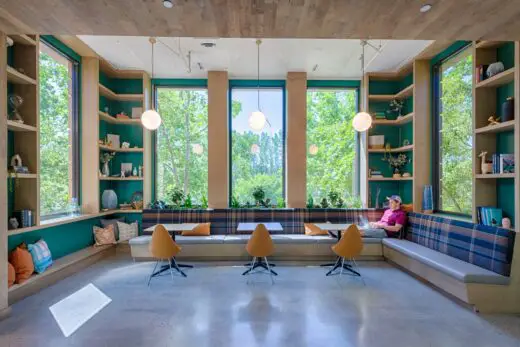
photo : Marco Zecchin
We know from firsthand experience and by way of designing for the needs of our clients that this agency, in addition to the innate collaborative aspects of shared workspaces, is what will increasingly define offices from now on, and will be the reason employees will largely continue to desire at least some time spent in the office.
And finally, key learning number three:
Communication is key
3. Communication is key.
“Not a new concept,” you may be thinking. And true enough, but with so many new variables and factors to consider, whether team members have opted to remain at home, return to the office, or somewhere in-between, there is now a need for more and better communication. For our remote team members, our internal data would indicate that increased attempts by supervisors to touch base frequently became a key factor in employee morale and retention. Additionally, communication from the leadership level to all of our team members on a consistent and expected basis took on new value through the worst of the pandemic.
Tammy Jones, Director of Human Resources, Cushing Terrell:

But perhaps most importantly, team member-to-team member communication took on renewed importance. With remote work adding new variables to the work-life balance, we learned that individual accountability was critical. There is no longer as much structure as our work environments once offered, meaning things are getting done at different times and perhaps in different intervals, but they are still getting done. Our team’s productivity has not suffered in remote/hybrid settings, and that can be largely attributed to our team members’ “team” attitude driven by personal accountability and autonomy.
As we now settle into what will most certainly be a permanent hybrid work model, we continue to track what is working for us as a design firm, for our team members, and for our clients, and what may yet need to change. And while change isn’t always easy, it’s exciting to be embedded within an industry that facilitates change in our spaces all the time. The next generation of workplace design is now upon us.
Next generation of knowledge work: hybrid workplaces information / images received 210622
A recent architecture article by Cushing Terrell on e-architect:
May 12, 2022
The Fluid, Sustainable Future of Retail Article
The fluid, sustainable future of retail
Another recent architectural article by Cushing Terrell on e-architect:
April 1, 2022
Data-Informed Design for User Experience at Work
Data-Informed Design for User Experience at Work
Comments on this article by Cushing Terrell are welcome.
Cushing Terrell
Cushing Terrell ATX Office
Architecture: Cushing Terrell
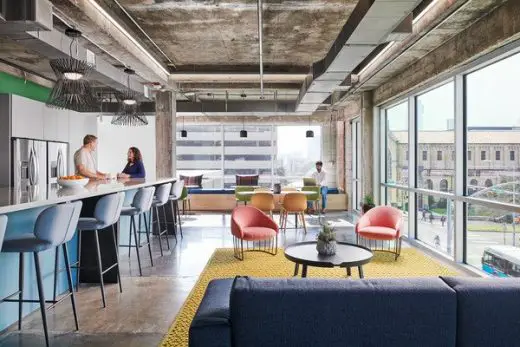
photograph : Peter Molick
Cushing Terrell ATX Office in Austin, Texas
Location: Austin, Texas, USA
Architecture in Texas
A US building design by Cushing Terrell Architects on e-architect:
Stockman Bank Missoula Downtown, Montana
A related article – the Design of the Workplace Report, Next generation office design:
Contemporary Texan Buildings
Design: Miró Rivera Architects
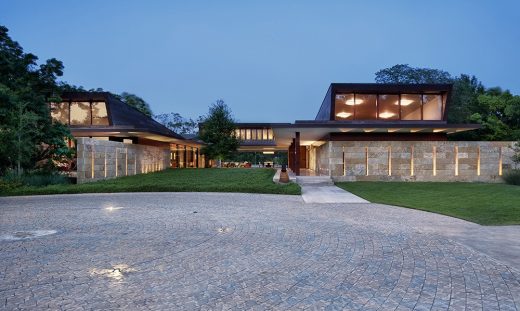
photograph : Paul Finkel, Piston Design
Residence 1446 in Austin
Design: Bercy Chen Studio, Architects
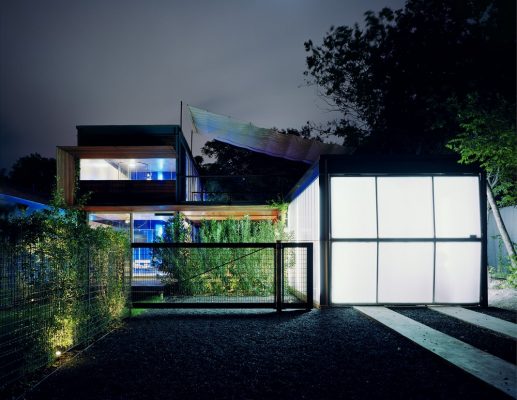
photo from architects
Annie Residence in Austin
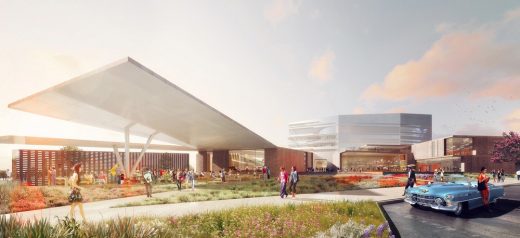
image from architect
Buddy Holly Hall of Performing Arts and Sciences in Texas
American Architecture Design – chronological list
Observation Tower at Circuit of the Americas Texas
Contemporary Rollingwood House, Travis County
Design: Bade Stageberg Cox, Architects
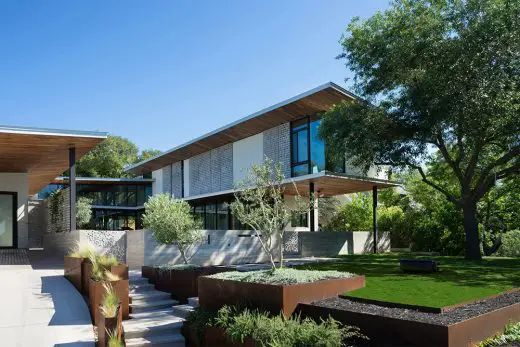
image from Chicago Athenaeum
Comments / photos for the Next generation of knowledge work: hybrid workplaces architectural article by Tammy Jones, Director of Human Resources, of Cushing Terrell USA page welcome

